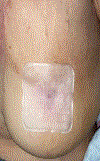Deferoxamine Intradermal Delivery Patch for Treatment of a Radiation Therapy Associated Breast Wound
- PMID: 39885938
- PMCID: PMC11781592
- DOI: 10.29011/2574-7754.101844
Deferoxamine Intradermal Delivery Patch for Treatment of a Radiation Therapy Associated Breast Wound
Abstract
Purpose: Radiation therapy is used in over 60% of cancer patients and can lead to radiation dermatitis, radiation induced fibrosis, hyperpigmentation, telangiectasias, fat necrosis, and poor wound healing. Deferoxamine (DFO) is an iron-chelating agent that has been used systemically to treat iron overload conditions and more recently been studied to treat radiation fibrosis. Through iron chelation, DFO stabilizes hypoxia inducible factor-1α, driving downstream upregulation of angiogenic factors, and reduces formation of reactive oxygen species, thereby offering a potential therapy for radiation associated chronic wounds. The purpose of this work was to describe treatment of a refractory wound following radiation treatment that had failed conventional therapy.
Methods: The patient is a 71-year-old female with inflammatory breast cancer that developed a radiation related wound after mastectomy, chemotherapy, and radiation therapy. The wound did not show any signs of improvement with five months of wound care and risk factor modification. The patient was offered treatment with a topical Deferoxamine Intradermal Delivery Patch through the FDA single patient investigative new drug pathway.
Results: After two weeks of treatment, the wound healed. Additionally, serum was collected at cessation of therapy and 5 weeks after, with both samples showing no significant systemically detectible level of the drug to be present. Subjectively the patient reported improvement in appearance and quality of the skin.
Conclusion: Topical deferoxamine is a promising therapy for radiation wounds. Although this report is limited to a single patient experience, we believe this work is important in describing the first in-human use of topical deferoxamine to heal a radiation therapy associated wound.
Keywords: Chronic Wounds; Deferoxamine; Iron Chelation; Radiation; Radiation Wounds; Wound Healing.
Conflict of interest statement
Conflict of Interest: The authors hold no conflict of interest.
Figures
Similar articles
-
Deferoxamine Intradermal Delivery Patch for Treatment of a Beta-Thalassemia Wound.Ann Surg Open. 2024 Jan 11;5(1):e372. doi: 10.1097/AS9.0000000000000372. eCollection 2024 Mar. Ann Surg Open. 2024. PMID: 38883943 Free PMC article.
-
Transdermal deferoxamine administration improves excisional wound healing in chronically irradiated murine skin.J Transl Med. 2022 Jun 17;20(1):274. doi: 10.1186/s12967-022-03479-4. J Transl Med. 2022. PMID: 35715816 Free PMC article.
-
Optimization of transdermal deferoxamine leads to enhanced efficacy in healing skin wounds.J Control Release. 2019 Aug 28;308:232-239. doi: 10.1016/j.jconrel.2019.07.009. Epub 2019 Jul 9. J Control Release. 2019. PMID: 31299261
-
Advances in Hypoxia-Inducible Factor-1α Stabilizer Deferoxamine in Tissue Engineering.Tissue Eng Part B Rev. 2023 Aug;29(4):347-357. doi: 10.1089/ten.TEB.2022.0168. Epub 2023 Feb 1. Tissue Eng Part B Rev. 2023. PMID: 36475887 Review.
-
Topical Iron Chelator Therapy: Current Status and Future Prospects.Cureus. 2023 Oct 26;15(10):e47720. doi: 10.7759/cureus.47720. eCollection 2023 Oct. Cureus. 2023. PMID: 38022031 Free PMC article. Review.
References
-
- FitzGerald TJ, Bishop-Jodoin M, Laurie F, Lukez A, O’Loughlin L, et al. (2019) Treatment Toxicity: Radiation. Hematol Oncol Clin North Am 33(6):1027–1039. - PubMed
-
- Bryant AK, Banegas MP, Martinez ME, Mell LK, Murphy JD (2017) Trends in Radiation Therapy among Cancer Survivors in the United States, 2000–2030. Cancer Epidemiol Biomarkers Prev. 26(6):963–970. - PubMed
-
- Early Breast Cancer Trialists’ Collaborative Group (EBCTCG), Darby S, McGale P, Correa C, Taylor C, et al. (2011) Effect of radiotherapy after breast-conserving surgery on 10-year recurrence and 15-year breast cancer death: meta-analysis of individual patient data for 10,801 women in 17 randomised trials. Lancet 378(9804):1707–1716. - PMC - PubMed
-
- Polgár C, Ott OJ, Hildebrandt G, Kauer-Dorner D, Knauerhase H, et al. (2017) Late side-effects and cosmetic results of accelerated partial breast irradiation with interstitial brachytherapy versus whole-breast irradiation after breast-conserving surgery for low-risk invasive and in-situ carcinoma of the female breast: 5-year results of a randomised, controlled, phase 3 trial. Lancet Oncol.18(2):259–268. - PubMed
Grants and funding
LinkOut - more resources
Full Text Sources


